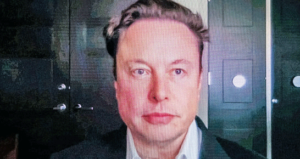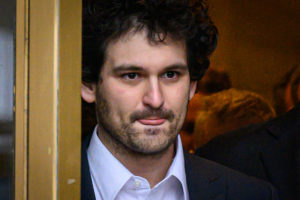In the pristine cylindrical atrium of Altos Labs’s Cambridge Institute of Science, under a skylight resembling a giant cyclopic eye, I ask the obvious question. What does the company actually do? “Cell rejuvenation,” replies the facilities manager. At least, looking back, I’m pretty sure that’s what he says. At the time, I hear something slightly different: “We sell rejuvenation.”
Home to one of the world’s highest concentrations of scientific talent, Altos Labs is pursuing a lavishly funded quest to unearth the secrets of ageing. The Stanford-meets-Soho House décor is enough to show that here, health is wealth. But even in the notoriously well-compensated field of biotechnology it stands out. Last year, the Silicon Valley venture revealed it had raised $3 billion from investors, making it one of the best-financed start-ups in history.
Its mission? Depending on who you ask, anything from reversing chronic diseases and deferring the helpless twilight of old age to cutting the keys of eternal youth and creating a race of immortal supreme beings. This furrow of science, which piques our hardwired anxiety of ageing and fear of death, has always been accompanied by disproportionate incentives for hype. Nor has it been helped by wealthy obsessives, who in recent years have very publicly taken their own anxiety to macabre new heights, such as the software entrepreneur Bryan Johnson, who injected himself with his son’s blood and spends $2 million a year in the hope of achieving the body of an 18-year-old.
Altos’s leaders, however, are in the business of managing expectations. Hans Bishop, the president, has said his focus is on increasing “healthspan” rather than lifespan, and that any extension in longevity would be “an accidental consequence”. The idea is that, by focusing on “reprogramming” cells with various proteins, Altos can find medicines that treat many diseases at once by targeting the underlying problem: ageing.
Bishop and his co-founders Rick Klausner and Yuri Milner are late entrants in the arena of anti-ageing research. Calico was set up a decade ago by Google co-founder Larry Page, though it has yet to unveil a product. Other players include Unity, BioAge, BioViva and AgeX Therapeutics. Billionaires — including Milner himself, Page, and Paypal co-founder Peter Thiel — are regularly glimpsed behind the scenes.
So what makes Altos stand out? Again, that war chest is immense. Its team is a fleet of Nobel prizewinners, lured from governments and top universities with the promise of “sports star” salaries. As for famous backers, Amazon founder Jeff Bezos himself is believed to be one of Altos’s investors. When rumours of Bezos’s involvement broke in 2021, fellow billionaire Elon Musk quipped: “If it doesn’t work, he’s gonna sue death!”
Altos is global, with two hubs in California, one in England near Cambridge, and one in Japan led by famous stem cell researcher Shinya Yamanaka. Given that all my imaginative efforts to visualise these mines of youth ended with giant brains in tanks, I am intrigued to be offered a tour of the UK hub by the building’s owners. My goal is to peer a little closer through the hype and see what $3 billion gets you.
Upstairs in the Cambridge branch, I am taken past rows of brand-new labs and a sterile area named the Science Kitchen, where some of the 160 scientists prepare for experiments on, among other specimens, mice and fruit flies. (You may recall from biology lessons that drosophilas are ideal for research since their rapid life cycle allows multiple generations to be bred in a single day.)
A vivarium, for raising and keeping animals, is being built downstairs, but I am refused entry as it is still undergoing environmental testing. It must be signed off by the Home Office, the facilities manager explains. Of all government departments, why that one? An answer is not forthcoming.
Science is a power-hungry enterprise, as evidenced by the colossal HVAC system out back, almost the size of the lab itself. The whole building is kept on backup power so that if there is an outage on the National Grid, Altos can continue to keep its industrial-strength freezers at -70°C. As we pass a room of these freezers, I point out that they are conveniently human-sized. “Is Walt Disney in that one?” I ask. No one laughs.
The superlative sci-fi element, however, is “Ken’s Egg”: a wood-panelled, 130-person lecture theatre on the ground floor named after Dr Ken Raj, one of the principal investigators. “I felt the egg was good,” Raj says. “What the auditorium is for is to bring our ideas, to give birth to life.”
Those ideas continue to advance. Raj, alongside his colleague Steve Horvath in the US, is an expert in epigenetics, measuring how molecules called methyl groups attach themselves to our DNA as we age. Most people’s DNA methylation age corresponds accurately with their chronological age, but those with diseases such as Parkinson’s have an older epigenetic age.
A couple of years ago, the big question was whether the methyl groups are driving the ageing process, or merely a consequence of it. Now, we know. “We can see now that yes, the methylation is actually the driver,” Raj tells me. “Not all of the methylation that happens in your genome drives ageing, but there are methylation genomes that actually do the driving.”
Some aspects of the science being pursued at Altos are more controversial than others. Charles Brenner, department chair at City of Hope medical centre in Los Angeles and a vocal critic of lifespan-extending hype, tells me that there is “a cart-horse problem” with DNA methylation. “There’s no evidence to my knowledge that a change in [epigenetic clock] means that a person is going to live longer,” he says.
Brenner says that epigenetic resetting “is real and will certainly turn into real medicine”, such as when your cells are used to create a tissue that has an exact genetic match for, say, your damaged liver. In vivo “reprogramming”, however, is in his opinion “unlikely to ever be tested in humans” because “everyone who works with these genes knows that they produce tumours and teratomas in the process of producing well-behaved stem cells”.
At conferences, Brenner shows his audience a letter from an anti-ageing scientist who claimed: “We can control ageing at our caprice… it’s going to revolutionise everything.” It was written in 1990. “It arguably could have been said by any anti-ageing biotech guy in the last 33 years,” he says. “And they were all wrong.” Despite this, Brenner expects that the “excellent scientists” at Altos will still “discover useful things”. However, he says, “it’s not obvious to me what new technologies would making drugging the ageing process to achieve lifespan extension suddenly possible. I suspect that some of the investors were sold a bill of goods.”
The political and ethical questions around Altos Labs are equally unsettled. The debates are familiar by now. Proponents see the quest for longevity as morally noble, arguing that it will eventually benefit all humanity. Detractors say there’s no evidence to suggest the benefits would trickle down to the non-billionaires.
David Sinclair, chief executive of the International Longevity Centre UK, tells me the key challenge is “helping us live better now rather than longer, and that is arguably a policy issue as much as a science issue”. The cynical view of Altos and its ilk, he says, is that there are “quite a lot of men in their 30s who want to live forever, and that they’re throwing lots of money into this. Actually, if you asked their 95-year-old mums, what would they say? Would they say you’re much better off making sure you’re doing it well, rather than living longer?”
Sinclair believes the investment in Altos is useful, but suggests policymakers will have to tackle the increased inequalities that might result from the science. “The people who will have access to it first are the people who are already living longer and are going to be wealthier,” he says. At the same time, “once you have new medications that work, it’s very difficult for governments not to offer them.”
Is it safe to say these companies have an image problem? Scepticism comes naturally in the field, ever since Herodotus lied (or, if you’re being charitable, was duped by a myth) about people bathing in a fountain of youth in the fifth century BC. It also strikes me as noteworthy that so many cultural depictions of eternal life and the quest for immortality, from Gilgamesh to Indiana Jones to Dr Manhattan, are cautionary tales.
Professor Tom Kirkwood, head of the department of gerontology at Newcastle University, tells me that research on ageing “is at quite an exciting stage” but sometimes the enthusiasm for innovative treatments “doesn’t pay sufficient regard to what we know already about the complexities of the ageing process”. It’s a great deal easier to alter the life history of short-lived animals such as fruit flies and mice than to alter the lifespan of humans, after all. As for Altos, Kirkwood believes it has the potential to be “slightly disruptive”, but, he says, “it would not surprise me if it should turn out that for all the investment that’s made, the breakthroughs prove to be elusive”. Yet he points out that researchers will continue to make bold claims in order to have their work recognised by the capricious attention of the media.
The wacky Bay Area sheen doesn’t help either. It brings to mind “transhumanists” such as Zoltan Istvan, who ran for US president in 2016 promising to conquer death, and philosopher Ingemar Patrick Linden, who calls the suggestion that everyone should die at a natural age “appalling”. Super-rich investors may not use this precise language, but there is undoubtedly a grain of transhumanism in their thinking. As he stepped down as Amazon CEO in 2021, Bezos urged shareholders to stay nimble, quoting Richard Dawkins: “Staving off death is a thing that you have to work at… If living things don’t actively work to prevent it, they would eventually merge with their surroundings and cease to exist as autonomous beings. That is what happens when they die.”
Altos’s scientists are all in, obviously. “This is what the world needs,” Raj says. Bezos and the rest have created lavish sanctuaries for these talents to thrive. And many would see nothing wrong with that. There are far worse ways to be a billionaire: look at Philip Green.
Yet the furtiveness with which he conducts his involvement (his investment firm, Bezos Expeditions, has still not commented on the Altos reports) speaks volumes about his self-interest. There are plenty of simpler ways Bezos could improve the lives of others. Let’s be clear: he really does want to be immortal. And I’m not sure there’s anything noble about that.
Surprisingly, one of Bezos’s fellow tech titans articulated a very different philosophy of ageing. In his 2005 commencement address to Stanford graduates, Steve Jobs reflected on his pancreatic cancer diagnosis and offered a powerful rebuke to Silicon Valley-style transhumanism. “No one wants to die. Even people who want to go to heaven don’t want to die to get there,” he said. “And yet death is the destination we all share. No one has ever escaped it.”
But that is as it should be, he said, because “death is very likely the single best invention of life. It is life’s change agent. It clears out the old to make way for the new.”
Disclaimer
Some of the posts we share are controversial and we do not necessarily agree with them in the whole extend. Sometimes we agree with the content or part of it but we do not agree with the narration or language. Nevertheless we find them somehow interesting, valuable and/or informative or we share them, because we strongly believe in freedom of speech, free press and journalism. We strongly encourage you to have a critical approach to all the content, do your own research and analysis to build your own opinion.
We would be glad to have your feedback.
Source: UnHerd Read the original article here: https://unherd.com/






